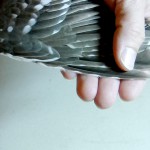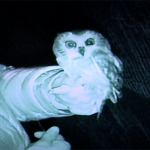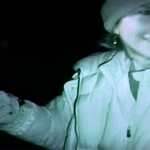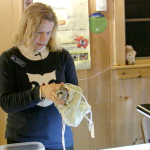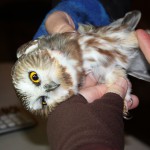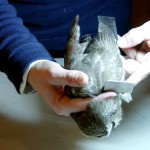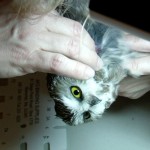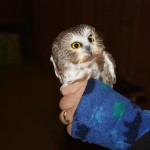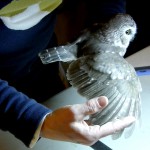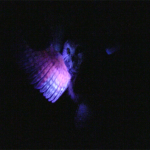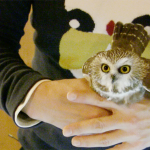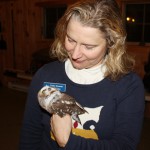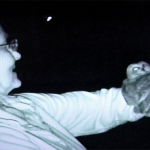Stalking the night stalkers
[youtube=http://www.youtube.com/watch?v=hseAI-_tpHM]
CAPTURING TINY SAW-WHET OWLS AS THEY MIGRATE …
It’s 8:45 in the woods of Lincoln, MA, and we’ve got our first Northern saw-whet owl of the night. She’s no bigger than a kitten—about 7 inches tall and weighing less than a stick of butter. The brown and white ball of feathers, talons, and huge yellow eyes hangs motionless in what looks like an overgrown tennis net. Among the smallest and most common owls in North America, these tiny predators are so secretive that I, like most people, including some avid birders, had never seen one in the wild before.

There’s something magical about experiencing the night in the company of a wild owl.
Photo: Christen Goguen
This owl, probably flying south like thousands of other saw-whets on their fall migration, had heard an irresistible song somewhere close to the ground and swooped down to investigate.
It was the voice of a male saw-whet, sounding a little like the repeated beeps of a truck backing up. Looped on a player and broadcast over and over, the call lured her downward where she became entangled in the soft, forgiving “mist” nets set up along a small trail under a canopy of trees.

Such a face! It’s easy to see how the banders become hypnotized by these beautiful birds.
Photo: Christen Goguen
Her eyes, and those of other owls, are famously good at seeing in the dark. But while she dodged trees and branches on her way in, her vision wasn’t quite good enough to detect the long swath of thin mesh set up to trap her. Within minutes of her arrival, an all-female SWAT team of four bird enthusiasts, each wearing a headlamp, discover her and begin to quietly disentangle her and place her in a cinched cotton bag. The women, led by Kathy Seymour, the banding station manager, are part of an army of volunteers, who are trying, bird by bird, to solve the mystery of the saw-whet.

Kathy Seymour has been banding owls for 11 years.
Photo: Christen Goguen
Saw-whets, with their furtive lifestyles (they hardly make a peep outside breeding season) and unorthodox views on migrating (some do, some don’t), have been dodging attempts to paint a clear portrait of them for centuries. Largely because they travel at night, it wasn’t until the early 1900s that it became known they migrated at all, flying in the fall from mating grounds in Canada and New England down to their feeding areas somewhere more southerly. That was unexpected, points out Tia Pinney, lead naturalist for Drumlin Farm: most other owl species “do NOT migrate. Their territories may expand or contract depending on time of year, food resources, nesting, those kinds of things, but saw-whets are truly migratory, traveling quite a distance for such a little creature.”
Mysterious and spooky:
from the freaky eyeball to the stealth wings
In the 1990s there was a leap forward in the effort to fill in the picture of the saw-whet when an ecologist with the Maryland Department of Natural Resources, Dave Brinker, started Project OwlNet. It’s a consortium of more than a hundred banding stations across the US and Canada. Seymour and her federally licensed band of bird banders, working out of Mass Audubon’s Drumlin Farm Wildlife Sanctuary, are an important part of that group. And the information that her team has gathered this past fall is just now being added to a growing database that they hope will help protect these birds. Saw-whets are not endangered, but it’s only by knowing how the owls live and travel that we can figure out how to keep their population healthy.

The information gathered about each owl, including weight, sex, and age, is recorded for Project OwlNet.
Photo: Christen Goguen
And so far, the population looks pretty healthy. Since 1960, nearly 250,000 saw-whet owls have been banded by various groups. Here in Lincoln, during some “big” years, when the number of migrators seems to crest, this crew has taken in as many as 62 owls in a single night during the annual weeks-long marathon between October first and the middle of November. Those figures conjure a staggering picture: over our heads, high up in the dark skies, thousands of tiny owls silently taking wing. This night at Drumlin Farm, we will have three visitors, about the average for the current season.

The cozy Pond House at Drumlin Farm in Lincoln is saw-whet central on fall nights.
Photo: Christen Goguen
It’s a short walk, crunching through fallen autumn leaves, from the mist nets to the Pond House, at Drumlin Farm. Here, a white plastic folding table has been set up where this saw-whet, and many others will be weighed, banded, measured, and released. Once inside, Kathy Seymour holds the owl securely using “the bander’s grip”—two fingers on either side of the neck, thumb and other fingers keeping the wings closed. The owl’s weight is taken, she’s 99 grams—6 grams over the typical upper end for a male, so we know we are almost certainly dealing with a female. Next, a half-gram aluminum band with a unique serial number is placed on her leg. At this moment, our little saw-whet becomes “115,” short for owl #1014-83115.

The bands are lightweight and are designed to spin freely without snagging feathers.
Photo: Christen Goguen
Seymour quickly moves on to gathering wing measurements (which also help determine sex), and conducting a feather assessment. Newer feathers are darker than the older, faded ones. And a black light, which makes certain pigments stand out, is used to scan her wings. These patterns of new and old feathers help determine age.

A black light makes certain pigments stand out and can help in determining if feathers are old or new.
Photo: Christen Goguen
First year owls have all new feathers, second-season birds have replaced the ones that take the most wear and tear, like those that make up the leading edge of the wing. And for birds older than that, the calculation becomes much more complicated. This owl is a second year.

Newer feathers appear darker–they haven’t had time to fade.
Photo: Christen Goguen
Not only her age, but her general fitness is being evaluated. So number 115’s body fat is gauged by blowing on the bird to part the feathers. Fat deposits can be seen much as they look in a grocery store chicken, Kathy points out. Throughout the procedure, our detained owl appears mellow. Aside from some swift beak clacking (which we can hear, but barely see), she is quiet. [youtube=https://www.youtube.com/watch?v=WF9cW8-hXoE] There’s very little struggling. In fact, when Kathy smooths the feathers on her head, which might mimic the preening of a mate, the little owl leans back and closes her eyes. She seems to be enjoying it. But is she really? Days later, I phone Dr. Greg Mertz, director of the New England Wildlife Center in Weymouth, and ask him to explain: Were these owls really calm, or did they just look that way?

This owl closes her eyes and leans her head back while being “preened.”
Photo: Christen Goguen
Dr. Mertz, who has treated hundreds of thousands of injured wild animals, says captive owls do seem serene, but, in fact, are not. If I had looked closely, I would have seen the pupils of the owl constricting and dilating. While being restrained, the little saw-whet was actually on high alert. It’s just that as a predator, she didn’t express it as wild wing flapping and screaming. “That’s not a response that’s built in as part of their survival mechanism,” the wildlife vet says. Still, her calm expression adds to her allure. Just looking at owl number 115, it’s easy to understand on an emotional level, why the volunteers are so dedicated to the work. “First of all,” Seymour says, “they’re CUTE.” And unlike the songbirds Seymour used to band, she sees the owls more as individuals—“where has she been? Why is this one so feisty?”

A captive saw-whet looks up at Susan Coe, one of the volunteer banders.
Photo: Christen Goguen
These birds also exhibit some intriguing lifestyle quirks. For instance, female saw-whets, larger than the males, incubate the eggs and stay for more than two weeks with the young while the male brings them food. The female keeps the nest spotless, but when she leaves, and the male takes over care, the nest becomes a pigsty—filled not with dirty socks and pizza boxes, but the avian equivalent—droppings and dead mouse bits.
OWL BANDING GALLERY
For Seymour, the experience is also very much about being part of the effort to solve a mystery. Where the saw-whets go in the south and which routes they take are high priority questions for those involved in the project. “They generally fly north to south,” Pinney says, “but how far south?” The saw-whets definitely reach Alabama and Georgia, and two wayward owls have even been found in Bermuda.

Tia Pinney: Naturalist, Adult Program and Ecological Management Coordinator, Drumlin Farm Wildlife Sanctuary.
And the routes they take? If scientists and the citizen scientists who volunteer for Project OwlNet can determine flight corridors, the information could be crucial to advising where wind farms should or shouldn’t be placed, for example. Some of the assumptions owl aficionados had developed earlier about the animals following the trajectory of mountains or rivers are not true of the owls that the Lincoln group has been banding. “Never has it been put in the historical literature that saw-whets migrated over suburbs,” Seymour says, “so we’re learning that pretty much they’re migrating on a broad front.” And which saw-whets choose to migrate? Of the ones who stay put, it’s thought that it’s mostly males who brave winters on home turf to secure breeding rights. It’s a tough undertaking since their prey—mice and voles—are hidden by snow, while simultaneously in some areas, the trees around them lose their leaves, exposing the tiny saw-whets to larger owls, like great-horned owls, who eat them. So the owl banders keep working to help fill in the picture. At the Pond House, when all of these observations have been recorded, owl number 115 is placed in a modified parakeet nesting box outside to allow her eyes to adjust to the darkness.

The banded owls are placed in modified parakeet nesting boxes outside Pond House so their eyes can readjust to darkness. This owl is about to take wing.
Photo: Christen Goguen
After several minutes, the wooden door is pushed up into the open position, and within seconds, the tiny saw-whet disappears into the night on her silent wings. We will capture two more owls this evening, both females, and after they are processed, it is late, and the work is done. By 11 p.m., one of the banders says that it’s “time to close the forest.” The four citizen scientists tie up and lock the nets, and then disperse into the darkness where the owls are wild owls once again and the women return to their roles as normal civilians. Tomorrow, the banders will be transformed back into a computer programmer, two teachers, and a college administrator, waiting, just like the saw-whets, for night to fall.





